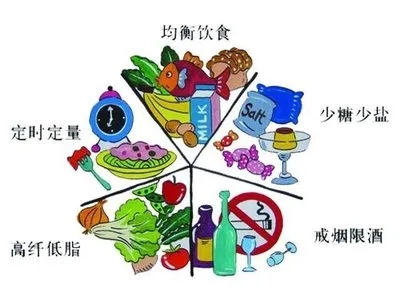
Diabetics' diet misunderstanding 1: Eat less staple food
Many patients believe that the less staple foods you eat, the better, and they even limit the staple food to only half or two to one or two per meal for several years. This will cause two consequences: one is that the total calories cannot satisfy the body due to insufficient intake of staple foods. The need for metabolism leads to excessive decomposition of body fat and protein, weight loss, malnutrition, and even starvation ketosis.
The second is to control the amount of staple food, but not to control the fat, snacks, meat and egg foods, so that the total daily calories far exceed the standard, and the fat intake is too much, so hyperlipidemia and cardiovascular disease are easily complicated. Diet control failed. In fact, the diabetic diet mainly controls total calories and fat. The staple food contains more complex carbohydrates, and the blood sugar rise is relatively slow, so you should ensure that you eat enough.
Diabetes
Diet misunderstanding 2: You can eat whatever you want
Some patients mistakenly believe that diabetes should not eat sweet foods. Salted bread, salted biscuits, and a large number of diabetes-specific sweetener foods on the market do not contain sugar, and they can be used to satisfy their hunger when they are hungry without control. In fact, all kinds of bread and biscuits are made of grain. Like rice and steamed buns, they will be converted into glucose in the body when eaten, causing blood sugar to rise. Therefore, this kind of food can be used to improve the monotonous taste and enhance the joy of life, but it must be counted into the total calories.
Diabetics’ diet misunderstanding 3: Millet can eat more without sugar
Some patients think that millet does not contain sugar. This view is also wrong. The sugar content of food is described in detail in the following food composition table. The sugar content of millet is almost the same as that of rice and flour.
Diabetics' diet misunderstanding 4: meat without sugar can eat more
Some patients like to eat meat. They think that meat contains very little sugar and can eat more. This view is wrong. Although meat contains very little sugar, the metabolism of meat and fat also depends on the insulin secreted by the body. Eating meat also increases the burden on the pancreas. There are also many patients with unreasonable eating habits and seldom eat meat. This approach is also wrong. Whether patients or healthy people, they should eat meat appropriately, eat scientifically, and have balanced nutrition, and they should not give priority to a certain kind. Food and nutrition must be comprehensive.
Diabetics' diet misunderstanding 5: Winter melon and pumpkin can lower blood sugar
Some patients believe that winter melon and pumpkin are hypoglycemic foods that can treat diabetes. This view is wrong. Winter melon and pumpkin are not medicines and cannot serve the purpose of curing diabetes, and they will increase blood sugar after large amounts of consumption. Therefore, the correct approach is to eat once every other week. And the amount must be small, not more than 3 taels at a time.
Diabetics’ diet misunderstanding 6: You can’t eat fruits if you have diabetes
Some patients think that if you have diabetes, you can’t eat fruits. This view is also wrong. Diabetics can eat fruits, but there is a prerequisite. Under the premise of good diabetes control, you can eat fruits twice a day. Between the two meals at around 10 in the morning and around 3 in the afternoon, the amount of fruit should be controlled at 1/8 each time for apples, pears, and peaches, 3-5 petals each time for oranges, half a banana each time, and each watermelon. Eat half a leaf at a time, only one kind of fruit at a time.
Diabetics' diet misunderstanding 7: The more vegetables the better
Many friends with diabetes think that they should eat more vegetables, the more dietary fiber the better. But this is not the case. Correction: Vegetables contain vitamins. You can eat more, but you should also eat them in moderation. If you eat too much, other nutrients will be lost. Correction: Encourage diabetic patients to reach the daily intake of dietary fiber recommended by the general population. That is, at least 500 grams of vegetables, 200 grams of fruits and a certain amount of coarse grains are consumed every day.
Diabetics’ diet misunderstanding 8: Drink less water to reduce urination
In addition, in order to reduce urination, some diabetic patients drink less water as much as possible in their lives. This is actually unscientific. Correction: Most diabetic patients have symptoms of polyuria, polyphagia and polydipsia, which are due to blood sugar. Increased plasma osmotic pressure increases, causing osmotic diuresis to cause polyuria; a large amount of water is excreted from urine, causing the body to lose water and feel thirsty, and then drink more. These symptoms sometimes even affect normal life. Some patients take the method of drinking less water, but this method is not advisable. Correction: Thirst means that the patient is in a state of lack of water, so the daily intake of water for diabetic patients should be at least 1,200 ml, which is equivalent to six glasses of water.








